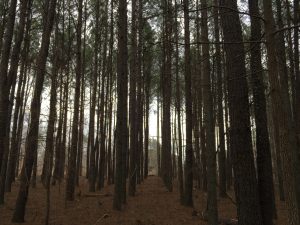On Tuesday, I took off to Eno River State Park and hiked the Laurel Bluffs Trail. It follows the river as it winds up into the forest, and circles around the old rock quarry. Setting out, my feet hit the packed orange clay with enthusiasm and my fingertips brushed up against wildflowers. The trees cast dappled sunlight on the shallow river, as it mumbled softly in the back ground. Decaying leaves were spotted with spring moss, and all was warm and peaceful.

Then the incline changed, not remarkably, but just enough to bring me above the river as it rambled off softly in the opposite direction. The trees were taller here, the sky darker. Nothing grew beneath the evergreen canopies. The blanket of slick pine straw dampened my footsteps, and the shadows drew long lines in the dirt, like bars of a cell.

I’ve hiked the trail before, but no matter what time of day or season, this particular bluff always makes me pause. It sets me on edge, as if something is going to step out from behind one of the conveniently human-size trees. This goose-bump inducing phenomenon made me wonder why one section of a trail could make me feel so much more uncomfortable than another section. Despite months of consideration, I’d never landed on an answer until Tuesday. Perhaps it was that I was looking at the trail through the lens of a camera, but suddenly is was so obvious.
Rows. The trees are growing in rows. The uniformity must be what puts me off when I walk this particular stretch. It seems so distinctly man-made and “unnatural” (in the sense that it has clearly been cultivated by human hands). The discovery seemed so clear, and yet it took me months to nail down. Below is an image showing the clear rows of pine, and it’s hard to miss when I really look back at it.

My discovery, as most do, unearthed a more questions than it answered. How long ago were the trees planted? What was this land before it was a state park? Why were the trees planted in rows, instead of a seemingly random orientation? Why does this striking uniformity unsettle me so much, when this is exactly the type of suburban uniformity I see in Durham every day? And finally, what separates our urban landscapes from the wild ones?
I don’t have all the answers, but I am happy to have figured out what makes that bluff so unpleasant. It serves as evidence of humans changing the environment, and now that I am aware of it, I can look for evidence of human development everywhere I go.